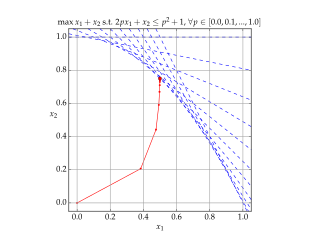
Linear algebra is the branch of mathematics concerning linear equations such as:
Quadratic programming (QP) is the process of solving certain mathematical optimization problems involving quadratic functions. Specifically, one seeks to optimize a multivariate quadratic function subject to linear constraints on the variables. Quadratic programming is a type of nonlinear programming.

Linear programming (LP), also called linear optimization, is a method to achieve the best outcome in a mathematical model whose requirements and objective are represented by linear relationships. Linear programming is a special case of mathematical programming.

In mathematics, a system of linear equations is a collection of one or more linear equations involving the same variables. For example,
In mathematical optimization, Dantzig's simplex algorithm is a popular algorithm for linear programming.
An integer programming problem is a mathematical optimization or feasibility program in which some or all of the variables are restricted to be integers. In many settings the term refers to integer linear programming (ILP), in which the objective function and the constraints are linear.
Column generation or delayed column generation is an efficient algorithm for solving large linear programs.

Interior-point methods are algorithms for solving linear and non-linear convex optimization problems. IPMs combine two advantages of previously-known algorithms:
Convex optimization is a subfield of mathematical optimization that studies the problem of minimizing convex functions over convex sets. Many classes of convex optimization problems admit polynomial-time algorithms, whereas mathematical optimization is in general NP-hard.
In mathematical optimization, the Karush–Kuhn–Tucker (KKT) conditions, also known as the Kuhn–Tucker conditions, are first derivative tests for a solution in nonlinear programming to be optimal, provided that some regularity conditions are satisfied.
In mathematical optimization theory, duality or the duality principle is the principle that optimization problems may be viewed from either of two perspectives, the primal problem or the dual problem. If the primal is a minimization problem then the dual is a maximization problem. Any feasible solution to the primal (minimization) problem is at least as large as any feasible solution to the dual (maximization) problem. Therefore, the solution to the primal is an upper bound to the solution of the dual, and the solution of the dual is a lower bound to the solution of the primal. This fact is called weak duality.
In mathematical optimization, the ellipsoid method is an iterative method for minimizing convex functions over convex sets. The ellipsoid method generates a sequence of ellipsoids whose volume uniformly decreases at every step, thus enclosing a minimizer of a convex function.
Semidefinite programming (SDP) is a subfield of mathematical programming concerned with the optimization of a linear objective function over the intersection of the cone of positive semidefinite matrices with an affine space, i.e., a spectrahedron.
The dual of a given linear program (LP) is another LP that is derived from the original LP in the following schematic way:
Benders decomposition is a technique in mathematical programming that allows the solution of very large linear programming problems that have a special block structure. This block structure often occurs in applications such as stochastic programming as the uncertainty is usually represented with scenarios. The technique is named after Jacques F. Benders.
In mathematical optimization, linear-fractional programming (LFP) is a generalization of linear programming (LP). Whereas the objective function in a linear program is a linear function, the objective function in a linear-fractional program is a ratio of two linear functions. A linear program can be regarded as a special case of a linear-fractional program in which the denominator is the constant function 1.
In applied mathematics, Graver bases enable iterative solutions of linear and various nonlinear integer programming problems in polynomial time. They were introduced by Jack E. Graver. Their connection to the theory of Gröbner bases was discussed by Bernd Sturmfels. The algorithmic theory of Graver bases and its application to integer programming is described by Shmuel Onn.
A separation oracle is a concept in the mathematical theory of convex optimization. It is a method to describe a convex set that is given as an input to an optimization algorithm. Separation oracles are used as input to ellipsoid methods.
The configuration linear program (configuration-LP) is a linear programming technique used for solving combinatorial optimization problems. It was introduced in the context of the cutting stock problem. Later, it has been applied to the bin packing and job scheduling problems. In the configuration-LP, there is a variable for each possible configuration - each possible multiset of items that can fit in a single bin. Usually, the number of configurations is exponential in the problem size, but in some cases it is possible to attain approximate solutions using only a polynomial number of configurations.
The Karmarkar–Karp (KK) bin packing algorithms are several related approximation algorithm for the bin packing problem. The bin packing problem is a problem of packing items of different sizes into bins of identical capacity, such that the total number of bins is as small as possible. Finding the optimal solution is computationally hard. Karmarkar and Karp devised an algorithm that runs in polynomial time and finds a solution with at most bins, where OPT is the number of bins in the optimal solution. They also devised several other algorithms with slightly different approximation guarantees and run-time bounds.



































